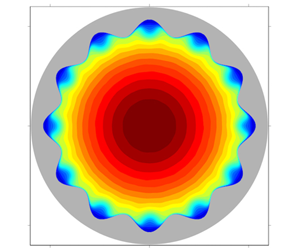Article contents
A direct comparison of pulsatile and non-pulsatile rough-wall turbulent pipe flow
Published online by Cambridge University Press: 20 May 2020
Abstract

Pulsatile rough-wall turbulent pipe flow is compared against its non-pulsatile counterpart using data obtained from direct numerical simulation. Results are presented at a mean friction Reynolds number of 540 for a set of three geometrically scaled roughness topographies at a single forcing condition, which, based on existing classifications, falls into the current-dominated very-high-frequency regime. By comparing the pulsatile data against an equivalent non-pulsatile dataset (Chan et al., J. Fluid Mech., vol. 854, 2018, pp. 5–33), the key differences (and similarities) between the forced and unforced configurations are identified. A major finding of this study is that the flow in the outer region retains its self-similar functional form under pulsatile rough-wall conditions, and, as a result, Townsend’s outer-layer similarity hypothesis holds for the roughness-forcing combinations considered here. On the other hand, the unsteady cases exhibit a rich array of flow physics in the region beneath the roughness crests not observed in the steady case. These differences are examined using a Moody chart, which encapsulates how the hydraulic properties of pulsatile rough-wall pipe flow differ from their non-pulsatile counterpart.
- Type
- JFM Rapids
- Information
- Copyright
- © The Author(s), 2020. Published by Cambridge University Press
References
- 9
- Cited by


